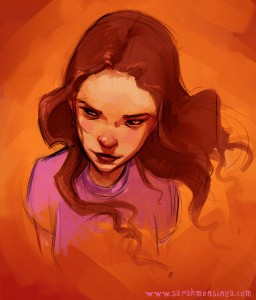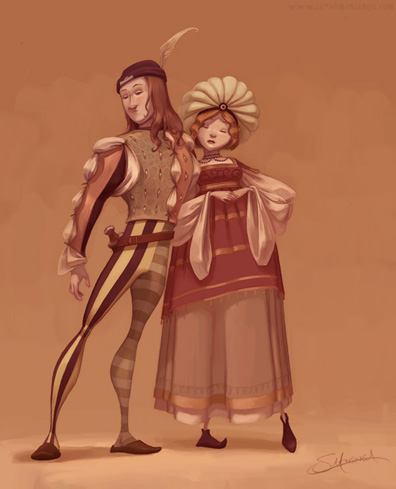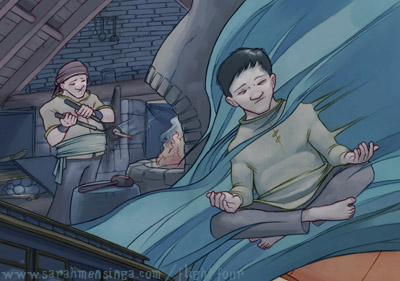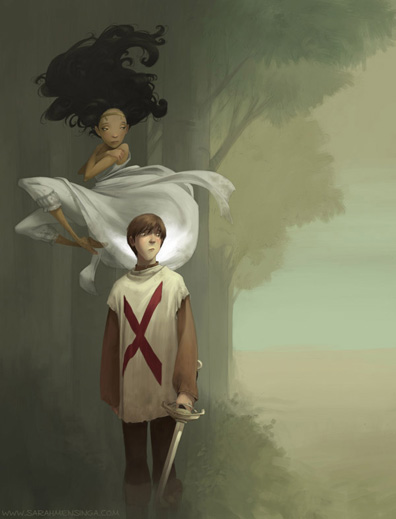Concept artist and animator for film and TV. Freelance artist and graphic novelist. Writer. There is no single word that encompasses Sarah Mensinga’s talent—well, maybe one: perfection.
.
While raising two lively, adorable children, Sarah creates images and stories of such exquisite charm they are as visual ambrosia for the soul. Like me, many have blissfully lost themselves for hours within her blog and online graphic novel. It was a rare treat to chat with her about her craft.
.
SARAH MENSINGA – ARTIST AND STORYTELLER
.
KARA: It is a real pleasure to interview you today, Sarah. Looking over your extraordinary work–the spot-on expressions of your characters, the vast landscapes created with fluid lines–I have to ask: Is it ever a struggle or does creating art always energize you?
.
SARAH MENSINGA: Hi Kara. Thank you for saying such nice things about my art, and thank you also for asking to interview me.
.
Art energizes me when it’s done and I can look at it and say “Look what I made! Yay!” But sometimes the process is not easy, particularly lately, when my time to paint and draw is very limited. Sculpting dragons out of play dough for my three-year-old is pretty energizing though. Who knew?
.
KARA: Many artists describe the pen or pencil as being an extension of their hands or bodies; much like a harpist becomes one with her instrument. The movement between person and instrument is inseparable. Do you experience the pencil as a tool or as an extension of yourself? Has it become a part of you?
.
SARAH MENSINGA: That sounds so lovely. I seem to only purchase pencils with a mind of their own. I do have fleeting moments of artistic control, but drawing often feels like a gamble. Fortunately though, the harder I work at it, the more weighted my die seems.
.
KARA: As far as pedagogy: Do you hold the pencil tightly or loosely? Any advice you would hand down to new illustrators, for releasing their style or for warming up the mechanics of drawing? Or opening the creative channels?
.
SARAH MENSINGA: I must hold the pencil pretty tightly; because I have permanent drawing callouses. But as for practical advice I can offer: Always draw with a sharp pencil. Invest in an electric pencil sharpener. And if you are frustrated by how smudgy graphite can be, use color-erase pencils. Much less smudgy.
.
As for creativity, sometimes it will be there, muse-like, but often you will not feel very creative. The good news is even when you don’t feel creative, you can always BE creative. It’s a matter of pushing yourself, patience, and maybe a good audio book to keep you from checking email/Facebook/twitter/fetching yummy snacks.
.
KARA: At what age did you know you wanted to draw? Has it been a gift? When I ask this I mean, did you just pick up a pen one day and say, “This feels right!” or did you first, like some of us *cough, cough*, have to conquer drawing stick figures and placing the sun behind the clouds?
.
SARAH MENSINGA: I have a very clear memory in kindergarten of there being a student art show at the board of education offices, and one piece of artwork from our class was to be selected by the end of the day. I dashed off this giant painted red flower, because I knew my teacher liked flowers and I knew it would be chosen. It was, and it was even hung on the door of our classroom for months after the show and everyone made this big fuss. All the while I remember feeling so guilty because I knew it wasn’t my best work. Ha ha, so I guess I must have considered myself some sort of artist with standards at age five.
.
Art has definitely been something I’ve always worked at, though, and still work at. If it wasn’t so challenging, I don’t think I would keep doing it.
.
KARA: Who most influenced you personally, gave you support and encouragement to be an artist?
.
SARAH MENSINGA: I’ve always been fortunate to be surrounded by supportive family and friends. My husband is particularly wonderful. He always takes a genuine interest in my stories and art, and does his best to give honest feedback.
.
In high school I babysat for a man who owned a successful graphic design firm. I remember once being frustrated because my illustration had been disqualified from my school’s year book cover contest over a technicality. In my irritation, I decided that I wouldn’t bother entering the contest again. I remember Bill telling me that things wouldn’t always be fair, and if I wanted to be successful, I had to be the person who would always pick myself up and try again.
.
I won the next year, and I always have that in the back of my mind.
.
KARA: If you were stuck in some dusty, cramped library that had only two art instruction books, one for illustration and another for animation, what titles would you hope to see?
.
SARAH MENSINGA: Hmm… to be honest, I don’t hold any art or animation instruction books particularly dear. But if I could choose two art reference books, I’d choose The Complete Costume History, by Auguste Racinet, and the Smithsonian Handbook of Mammals.
.
KARA: How important is it to be an observer of the world when you are an illustrator or an animator?
.
SARAH MENSINGA: If I’m ever drawing or animating badly, it’s probably because I didn’t do enough research. However, I think there’s something to be said about balancing working with reference, and pushing reality through your imagination filter. What I mean is, not always copying what you see, but reinterpreting how things look and finding a way to put your own stamp on it.
.
KARA: Are there some projects you will not touch in a bad mood? In a good mood?
.
SARAH MENSINGA: So long as I know I have undo, or delete, or a previously saved version of something, I’ll work on anything when I have a few free moments … with the HUGE exception of watercolor paint. That’s definitely good mood only. Watercolors are scary!
.
KARA: Speaking of projects I wanted to point out the shorts you did for Flight Four and Flight Five.
.
First, “The Forever Box”. I think it’s a subject everyone has experienced: the wish to just find a box somewhere and leave the world behind. Do you remember when this story came to you?
.
SARAH MENSINGA: I had an idea for a fairytale-type story featuring a king with a magic box that stopped time so he could always be king. But Kazu Kibuishi (Flight’s Editor) offered some great advice that we should consider working something personal into our stories. I haven’t experienced the kind of loss the main character in the story does, but there is an undercurrent of my love of Toronto, how much I miss my family there, and how I sometimes feel isolated because of the distance.
.
KARA: There are many layers to this story as I review it again. Her brothers brought home her means or tool (the box) to ‘deal’ or ‘not deal’ with their imminent tragedy. Would you like to elaborate on this or explain where you were coming from, what you wished to convey to the reader?
.
SARAH MENSINGA: I’m the sort of writer that always feels like I’m along for the ride. I usually don’t know what symbolism is in my stories until they are done, or other people point them out for me.
.
I planned on ending the Forever Box with the girl being saved by the boy in the future, finding love and all that. I’m really not a pessimist. I like thinking that everything broken can be fixed. But when I thought of the more melancholy ending, I knew that was the ending whether I liked it or not. It was honest to the story. It fit.
.
KARA: In some sense, her imagination both saves and traps her.
.
Now “The Changeling” is a different style altogether. The characters are thick and blocky. There’s this great use of space above them, sort of squishing or shrinking them in the beginning, but then at the end the high sky hints of a world of promise, with bowing trees. Why did you choose this style or mood for “The Changeling?”
.
SARAH MENSINGA: Ha ha, and there’s an example of symbolism I had no idea was there! I actually just had an image in my mind of a stylized dark-haired girl when I thought of the story. I wasn’t completely happy with the way that comic looked in the end, it felt rushed to me. However, I learned a lot while working on it and were I to paint another comic in a similar way, I’m sure it would turn out better.
.
That is what I love about anthologies; it’s an opportunity to dabble in different styles without the pressure of a full length project.
.
KARA: The expression on the girl’s face when she is carried away and her paramour’s expression, in return, are just heartbreaking. No need for a lot of dialogue in this story, right? How do you decide–dialogue versus image?
.
SARAH MENSINGA: I try to only put words where they need to go and if I can do without words altogether, even better. I’m also really fond of trying to keep narration out of my comics. Obviously the Forever Box has it, and probably needs it, but narration can make me a lazy storyteller. The visuals are just as powerful as words when it comes to comics, so I try to trust them as much as I can.
.
KARA: I see “The Changeling” as a story about kindness amidst judgment or prejudice. Her reward is her new family. How has your story craft changed since starting a family? Has it changed the way you approach content or character POV in any way?
.
SARAH MENSINGA: Hmm, strangely I’m finding this one of the hardest questions in the interview. I’m sure becoming a mother has changed my writing in some way, but I’m finding it difficult to say how. Story-wise, things feel pretty much the same. If anything, I’d say my writing has more of a purpose now that I have two little innocent people to care for. It’s not just about creating a story anymore. It’s also about what I’m going to do with that story when it’s complete.
.
The Changeling though, came about when my husband and I decided to start a family. I was thinking a lot about becoming a mother and the impact of having a baby. That led me to consider how pregnancy has changed other women’s lives throughout history.
.
KARA: Now I have seen “The Changeling” in both electronic and print form. Which medium do you prefer? It seems electronic stays true to the color but print has that wonderful tactile experience!
.
SARAH MENSINGA: Definitely print. I love ebooks and can’t wait to get an ereader. But seeing artwork, particularly digital artwork, in print form somehow makes it more real.
.
KARA: Recently you mentioned on your blog that you are experimenting more with drawing and painting software for your graphic novel, right? How is that going? Do you like it so far?
.
SARAH MENSINGA: It’s going well! I doubt I’ll ever finish the final art for the Wellington Division, though, it’s just too massive. But I do plan to write other graphic novels, and I’m constantly thinking about how I can draw and paint comic pages in efficient-and-also-pretty ways.
.

.
KARA: In your graphic novel “The Wellington Division”, two priests, Chose Ghell and Chose Tonomme capture a sprite and are subsequently banned from the Priest Elite for a year. Their plot to get reinstated takes them on quite an adventure. The novel is breathtaking. I am thoroughly enjoying it. Tell us a little about the story. This has been with you a long time, hasn’t it?
.
SARAH MENSINGA: Thanks Kara! I’m really glad you like it.
.
I think all writers have those stories that they’ve been working on for ages and ages, the Wellington Division is definitely mine.
.
When I was fifteen, a summer job fell through and it was too late to get another, so instead I wrote a novel. In that version, Elsie and Tyler were the protagonists. It was very Narnia-ish in structure. Emperor Viperal was in it and Tearse was added because I thought the Emperor needed an underling. I later rewrote the book after college, gutting most of it. I realized then, however, that even though Elsie and Tyler gave the story its beginning and end, their actions didn’t drive it. I also thought Tearse’s moral struggle made him the most interesting character, and once I shifted the POV to him, everything took shape.
.
KARA: Cool! Tearse is one of my favorite characters.
.
SARAH MENSINGA: Thanks! Yeah, he’s got this rotten-yet-charming thing going on which makes him so much fun to write.
.
KARA: How did your story transform into a graphic novel?
.
SARAH MENSINGA: The decision to turn the Wellington Division into a graphic novel happened after a few trips to the San Diego Comic Convention. I had always kept my art and writing separate, but meeting so many talented author/illustrators inspired me to bring my two passions together.
.
KARA: When you placed the first pages on your website, what did it feel like? Was it a release? Were you nervous?
.
SARAH MENSINGA: I really wanted to finish the Wellington Division, and I’m not the sort of person who gives up on things lightly. Deciding to stop working on the final art was extremely difficult and emotional. It was admitting failure — admitting that now that I had kids I had to let go of my art career in a substantial way. And knowing that the Wellington Division, something I had poured so much of my heart into, was just sitting there unfinished while I changed diapers and mashed frozen peas, was hard.
.
Posting the roughs lifted a huge burden. I know it sounds weird, but by not finishing the final art, I felt like I’d let my story down — without final art, it couldn’t be published and would never be read. Now, whether I ever finish the final art or not, the Wellington Division is out there, people are reading it and that’s amazing and wonderful. Best feeling ever.
.
I actually wanted to post all six parts at once and just be done with it, but my husband thought it would be better to use the comic as an excuse to regularly update my blog. It was good advice, because replacing my handwritten scrawl with a more legible font on seven-hundred and sixty pages is taking FOREVER. It’s good to have those Monday deadlines.
.
KARA: Why free? Do you plan to publish a hardcopy sometime?
.
SARAH MENSINGA: I’m a story drug dealer; the first one’s free… Ha ha. 🙂
.
No, as I mentioned before, it would take a LOT of work to make the Wellington Division publishable. The artwork’s not scanned at a remotely print-worthy resolution, and because I never intended to have anyone see these pages, the drawing is often embarrassingly rough. It makes more sense for me to focus on new projects, at least right now.
.
.
KARA: Following your artwork, placed out there from rough, to blue line, to drop-paint polish, is a real learning experience. To watch your pages as they unfold breaks down the mystique and reveals a process to illustrating that makes wonderful sense. Was this your hope?
.
SARAH MENSINGA: It wasn’t, but if it helps other artists then it’s a very happy accident. I love seeing other artist’s rough work, too. I always learn a lot.
.
KARA: What can we expect in the future on your website or in print? Any new projects?
.
SARAH MENSINGA: I have far too many new projects and I’m in the process of attempting to settle down and focus on one. Right now the front runner seems to be a middle-grade novel. I also hope to color the artwork for the children’s books on my website, Extraordinary and The Very Special Hat, and perhaps eventually create final artwork for The Dindle and Dragon Girl too.
.
KARA: Is there anything you would like to add? A bit of advice or a comment?
.
SARAH MENSINGA: I suppose I can share the advice I’m giving myself these days. Be patient, be persistent and forgive yourself. And if you have a baby, smell their little face. It makes them laugh, and when your baby is laughing, who cares about a bad drawing, unfinished graphic novels or pretty much anything else.
.
KARA: Thank you so much for taking the time to stop by and chat, Sarah! Very inspiring! Readers can enjoy more of Sarah’s work through her website, blog, and The Wellington Division graphic novel site. You can follow Sarah on Twitter and Google Follow via her blog. One can literally lose days immersed in her blog, not to mention the incredible graphic novel for FREE on her site. Simply golden, truly.
.
And thank you, readers, for stopping by. Feel free to leave a comment. There might be a delay in posting, but I appreciate your patience! -Kara







So cool to find out more about this fantabulouslyawesome (yet so humble) artist and writer. She’s really inspiring, and I must add that her kids are pretty darn cute.
I agree 100%, Deanna! Thanks for stopping by!
-Kara
Thanks for introducing me to Sarah whom I’m embarrassed to say I was not familiar with. Obviously my gain to have rectified that! What beautiful visuals and words!! =) I’ll be coming back to follow more of the links!! Thanks again!
I got to know about Sarah through stumbleupon and a subsequent search in Google.I must say she is a very talented artist.all her stuff is beautiful and lovely.I would be looking forward to more of her art in her blog and website.
Best wishes and regards to Sarah and her family
I also found this lovely work through stumbleupon, and have absolutely nothing negative to say about it. Delightful art from an admirable artist.